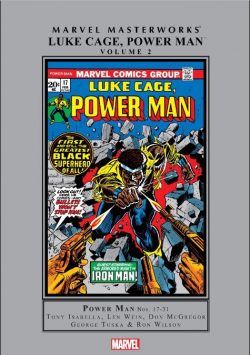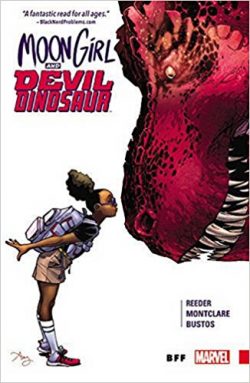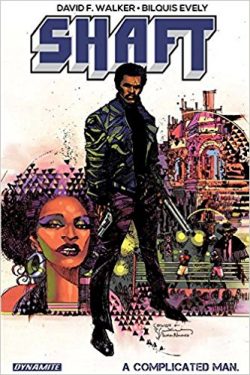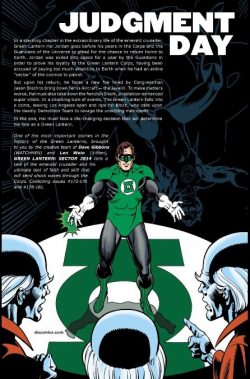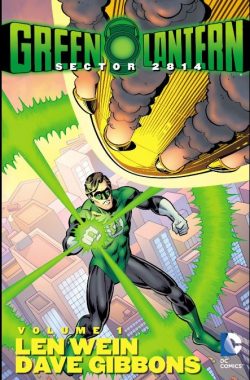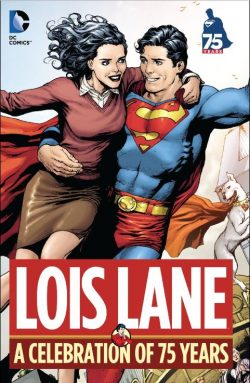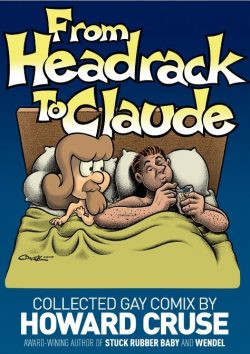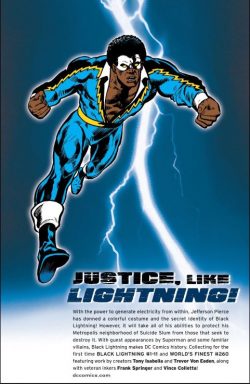
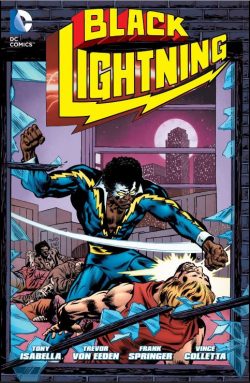
By Tony Isabella, Denny O’Neil, Trevor Von Eeden, Mike Netzer, Frank Springer, Vince Colletta & various (DC Comics)
ISBN: 978-1-4012-6071-2
As a pale, sickly kid growing up in a uniformly and unrelentingly white area of the Home Counties in the 1960s, I got almost all my early experience of black people from television and films (for which I’m most profoundly sorry) – and, of course, comics – for which I’m not.
Almost completely unaware of the struggle for racial equality in my formative years, the incredible consciousness-raising explosion of Black Power after the 1968 Olympic Games somewhat politicised me and gripped my unassailable sense of fairness.
However, in my village and school, even though some comics companies had by this time made tentative efforts to address what were national and socio-political iniquities, issues of race and ethnicity took a long time to filter through to the still-impressionable young minds avidly absorbing knowledge and attitudes via four colour pages that couldn’t even approximate the skin tones of African-Americans.
As the struggle progressed, on television and in comics breakthroughs were small, incremental and too often reduced to a cold-war of daringly liberal “firsts.â€
Excluding a few returning characters in Jungle-themed comicbooks of the 1940s and 1950s, War comics truly opened the door in the early 1960s, with Robert Kanigher & Joe Kubert creating negro boxer Jackie Johnson as a stalwart member of Sgt. Rock‘s easy company in Our Army at War #113 (December 1961).
Marvel followed suit with a black member of Sgt. Fury’s Howling Commandos team (Gabe Jones who debuted in #1, May 1963, but was accidentally re-coloured Caucasian at the printers: hard-working artisans who clearly didn’t realise his ethnicity), but pulled ahead in the diversity stakes after introducing Americas’ first negro superheroes Black Panther (Fantastic Four #52, July 1966) and the Falcon (Captain America #117, September 1969).
The honour of being the country’s first black hero to carry in his own title came via a little-remembered (or regarded) title from Dell Comics.
Created by artist Tony Tallarico & scripter D.J. Arneson, Lobo was a gunslinger and vigilante in the wild west who sought out injustice just like any cowboy hero would. He first appeared in December 1965 with his second and final issue cover-dated October 1966…
Arguably a greater breakthrough was Marvel’s Joe Robertson; City Editor of the Daily Bugle and a smart, brave, competent and magnificently ordinary mortal distinguished by his sterling character, not a costume or skin tone. He debuted in Amazing Spider-Man # 51 (August 1967), proving in every panel that the world wouldn’t end if black folk and white folk worked and ate together…
This big change slowly grew out of raised social awareness during a terrible time in American history – although Britain had nothing to be smug about either. Race riots had started early in the Sixties and left simmering scars that only comedians and openly racist politicians dared to talk about.
Shows such Till Death Us Do Part and Love Thy Neighbour made subtly telling headway but still raise a shudder whenever I see clips today…
Slowly, more positive ethnic characters appeared, with DC finally getting a black-skinned hero in John Stewart (Green Lantern #87, December 1971/January 1972), although his designation as a “replacement†Green Lantern might be construed as more conciliatory and insulting than revolutionary.
Jack Kirby had introduced teen New God Vykin the Black in Forever People #1 (March 1971) and created ghetto kid Shilo Norman as the hero’s apprentice (and eventual successor) in Mister Miracle ##15 (August, 1973) but DC’s first superhero to have his own solo title was Black Lightning, who didn’t debut until 1977…
Now with the urban avenger the star of his own television series, those early groundbreaking adventures have been gathered into an astoundingly accessible, no-nonsense trade paperback and eBook collection (comprising Black Lightning #1-11, plus material from Cancelled Comics Cavalcade #1 and World’s Finest Comics #260, cumulatively spanning April 1977 to January 1980) that dashes into action following a forthright and informative Introduction by series and character originator Tony Isabella.
It all begins as ‘Black Lightning’ (illustrated by neophyte penciller Trevor Von Eeden & veteran inker Frank Springer) sees former Olympic decathlete Jefferson Pierce return to the streets of Suicide Slum, Metropolis to teach at inner city Garfield High School.
Pierce is determined to make a difference to the troubled kids he used to be numbered amongst, but when the educator interrupts a drug buy on school grounds and sends the dealer packing, the door is opened to vengeance and tragedy.
When the mob – an organised syndicate dubbed The 100 – come seeking retaliation, one of Pierce’s students pays the ultimate price and the teacher realises he needs the shield of anonymity if he is to win justice and safety for his beleaguered home and charges…
Happily, tailor Peter Gambi – who took Jefferson and his mother in after the elder Pierce was murdered – has some useful ideas and inexplicable access to some pretty far-out technology…
Soon, equipped with a strength-&-speed enhancing forcefield belt and costume, with mask and wig that completely change his appearance, a fierce new vigilante stalks the streets of Metropolis…
The local chapter of The 100 is run by a monstrous and cunning freak called Tobias Whale and once Black Lightning’s harrying of his soldiers starts to bite into profits and give the downtrodden populace a glimmer of hope, the sinister strategist starts laying traps, culminating in hiring a lethal super-assassin who previously battled Green Arrow and the Justice League of America.
When the killer pounces, Pierce is forced into an uneasy alliance with mystery woman Talia Al Ghul, but their alliance ends as soon as the bodies start piling up all over the school gym in ‘Merlyn Means Murder’…
As Vince Colletta assumes the inker’s role, Black Lightning’s continued war against The 100 forces “the Whale†to fight smart, and Metro Police – led by doughty Inspector William Henderson – begin pursuing the mysterious vigilante as vigorously aa any gangster or felon. Taking seedy stoolie Two Bits Tanner into his confidence, Pierce savagely works his way up the criminal chain of command. He eventually confronts Tobias in his inner sanctum only to find ‘Every Hand Against Him’ as someone the police pounce. Has someone he trusts betrayed him?
A more palatable answer seems apparent in #4 as suspicion falls on Tanner’s source, Daily Planet journalist Jimmy Olsen. When the outraged Pierce tries to force a confession from the baffled cub reporter, they are attacked by the 100’s latest super heavy in ‘Beware the Cyclotronic Man’.
Although they combine to fight off the atomic villain Jimmy is hurt and Black Lightning is suddenly confronted by the kid’s enraged and late-arriving best pal, who jumps to the wrong conclusion and quickly proves ‘Nobody Beats a Superman!’
In fact, had Cyclotron not switched attention to the true target the Whale wanted him to kill, everybody might have died, but the heroes’ misunderstandings are all forgotten when Lightning saves the Man of Tomorrow from a nuclear meltdown, beats the bad guys and uncovers a mole in the police force…
His patience exhausted and under pressure from his own bosses, the Whale declares open season and offers an astounding bounty on Black Lightning. When deeply conflicted manhunter Syonide (and his hilarious Marvel-baiting in-joke kung fu assistants) stalk the Saviour of Suicide Slum, their first move is to shadow and learn everything about their quarry.
Before long Gambi is abducted and Jefferson’s secret finally exposed in ‘One Man’s Poison’…
Afflicted with a bizarre sense of honour, Syonide hands over a helpless Black Lightning to the Whale in #7: ‘The Conscience of the Killer’ compelling him to shelter the captive tailor from the 100’s vengeance and voluntarily pay the ultimate price when ordered to kill the seemingly-helpless masked hero.
Tragically, even as Black Lightning undergoes a miraculous transformation and takes out the gathered crooks and villains, he loses another innocent to the new violent life he has embraced…
With the power of the 100 apparently broken and Tobias Whale in custody, the fight seems over until the gigantic gangster breaks free and takes hostages from Police HQ. Determined to end the vendetta Black Lightning tracks him down for one last duel and in the ‘Deadly Aftermath’ finds purpose to carry on his alternate lifestyle…
Now considering himself more hero than avengers, Pierce experiences ‘Fear and Loathing at Garfield High’ when the school is invaded by a maniac terrorist operating an army of robotic killers after which a circus trip exposes ‘The Other Black Lightning’. Unfortunately, although the well-meaning admirer is a mostly-harmless copycat, a gang of jewel thieves and former Flash foe The Trickster provide plenty of genuine danger and menace before the big top sawdust settles…
Comicbooks were experiencing another general sales downturn at this time just as Denny O’Neil took over the scripting, Black Lightning was cancelled with the 11th (October 1978) issue.
‘All They Will Call You Will Be… Deportee!’ offered promise of a new direction as the urban avenger exposed an insidious people trafficking ring luring South American refugees into slave jobs at a fast food chain, but for most readers that was the last sight of the hero for some time.
So abrupt was the cancellation, that for legal reasons and to secure copyrights, DC had to put out a black-&-white ashcan anthology entitled Cancelled Comics Cavalcade, printing completed but unpublished stories of Claw the Unconquered, The Deserter, the Green Team, Madame Xanadu, Firestorm and others, including Black Lightning #12.
The wider world got to see that last adventure – ‘Lure of the Magnetic Menace’ by O’Neil, Mike Nasser (nee Netzer) & Colletta – a year later when the January 1980 cover-dated World’s Finest Comics #260 ran the story as a prelude to a series of new BL back-up adventures.
This edgy yarn details how the electrifying hero is attacked by costumed crazy Doctor Polaris after Jefferson Pierce investigates a possible case of child neglect and abuse involving one of his more troubled students…
Wrapping up this initial outing is a copious selection of working drawings from the ‘Black Lightning Sketchbook’ by Von Eeden and Mike Netzer’s unfinished cover for never-seen issue #13.
Although closely interlinked to then-current DC continuity, these fast-paced Fights ‘n’ Tights thrillers are so skilfully constructed that even the freshest neophyte will be able to settle in for the ride without any confusion and enjoy a self-contained rollicking rollercoaster of terrifically traditional superhero shenanigans.
So, go do that then…
© 1977, 1978, 1979, 2016 DC Comics. All Rights Reserved.


